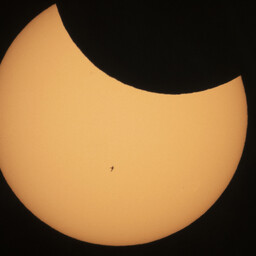Laupäeval, 29. märtsi lõuna paiku toimub
osaline päikesevarjutus
. Kuu katab Eestist vaadatuna kuni 16 protsenti päikesekettast. See tähendab, et
päike ei varju täielikult
ja pimedus ei tule.
osaline päikesevarjutus
Tõlge fraasile: osaline päikesevarjutus
EN
partial solar eclipse
päike ei varju täielikult
Tõlge fraasile: päike ei varju täielikult
EN
the Sun is not completely obscured
Laurits Leedjärv Tartu observatooriumist ütleb, et väikese varjutuse korral ei lähe taevas eriti pimedaks. Selleks peab kuu katma vähemalt pool päikesekettast.
Päikesevarjutust on ohtlik vaadata ilma kaitseprillideta. Ka tavalised päikeseprillid ei piisa. Kasutada võib näiteks tahmatud klaasi,
vana CD ketast või tumedat plastitükki
.
vana CD ketast või tumedat plastitükki
Tõlge fraasile: vana CD ketast või tumedat plastitükki
EN
an old CD or a dark piece of plastic
Osaline päikesevarjutus tekib, kui
Maa, Kuu ja Päike ei ole täpselt ühel joonel
. Täielik varjutus toimub, kui need kolm on joondatud.
Maa, Kuu ja Päike ei ole täpselt ühel joonel
Tõlge fraasile: Maa, Kuu ja Päike ei ole täpselt ühel joonel
EN
Earth, Moon, and Sun are not exactly aligned
Tallinnas algab varjutus kell 12.51
ja lõppeb kell 14.23. Kõige rohkem varjutatakse kell 13.37.
Tallinnas algab varjutus kell 12.51
Tõlge fraasile: Tallinnas algab varjutus kell 12.51
EN
the eclipse begins in Tallinn at 12:51
Vaadates päikest, võib näha päikeseplekke. Selleks vajad päikeseteleskoopi või muud suurt riista.
Mõnes kohas korraldatakse avalikke vaatlusi. Näiteks Tartus toimub see Toomemäel Tähetorni juures.
Järgmine täielik päikesevarjutus toimub Eestis 2126. aastal. Varem saab seda näha 2026. aastal Hispaanias ja Portugalis.
On Saturday, March 29, around noon, a partial solar eclipse will occur. From Estonia, the Moon will cover up to 16 percent of the Sun's disk. This means that the Sun will not be completely obscured, and darkness will not occur.
Laurits Leedjärv from the Tartu Observatory says that in the case of a small eclipse, the sky will not darken significantly. For this, the Moon must cover at least half of the Sun's disk.
It is dangerous to watch a solar eclipse without protective glasses. Regular sunglasses are also insufficient. You can use, for example, smoked glass, an old CD, or a dark piece of plastic.
A partial solar eclipse occurs when the Earth, Moon, and Sun are not exactly aligned. A total eclipse occurs when these three are aligned.
In Tallinn, the eclipse will begin at 12:51 PM and end at 2:23 PM. The maximum coverage will occur at 1:37 PM.
When looking at the Sun, you can see sunspots. For this, you need a solar telescope or other large instrument.
In some places, public observations are organized. For example, in Tartu, it will take place at the Observatory on Toomemägi.
The next total solar eclipse will occur in Estonia in 2126. Earlier, it can be seen in 2026 in Spain and Portugal.

